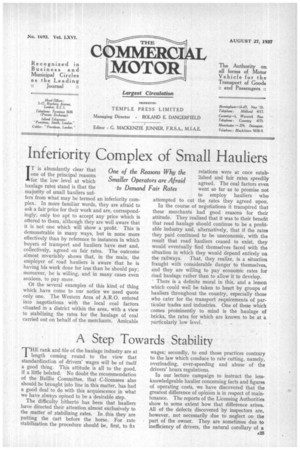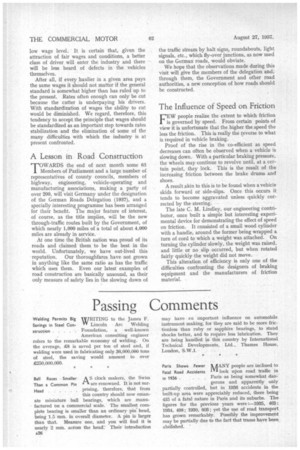A Step Towards Stability
Page 27

Page 28

If you've noticed an error in this article please click here to report it so we can fix it.
THE rank and tile of the haulage industry are at length coming round to the view that standardization of drivers' wages will be of itself a good thing. This attitude is all to the good, if a little belated. No doubt the recommendation of the Baillie Committee, that C-licensees also should be brought into line in this matter, has had a good deal to do with this acquiescence in what we have always opined to be a desirable step. The difficulty hitherto has been that hauliers have directed their attention almost exclusively to the matter of stabilizing rates. In this they are putting the cart before the horse. For rate stabilization the procedure should be, first, to fix wages; secondly, to end those practices contrary to the law which conduce to rate cutting, namely, overloading, over-speeding and abuse of the drivers' hours regulations.
In our lecture campaign to instruct the lessknowledgeable haulier concerning facts and figures of operating costs, we have discovered that the greatest difference of opinion is in respect of maintenance. The reports of the Licensing Authorities show to some extent how that difference arises. All of the defects discovered by inspectors are, however, not necessarily due to neglect on the part of the owner. They are sometimes due to inefficiency of drivers, the natural corollary of a low wage level. It is certain that, given the attraction of fair wages and conditions, a better class of driver will enter the industry and there will be less heard of defects in the vehicles themselves.
After all, if every haulier in a given area pays the same wages it should not matter if the general standard is somewhat higher than has ruled up to the present. Rates often enough can only be cut because the cutter is underpaying his drivers. With standardization of wages the ability to cut would be diminished. We regard, therefore, this tendency to accept the principle that wages should be standardized as an importint step towards rates stabilization and the elimination of some of the many difficulties with which the industry is at present confronted.
A Lesson in Road Construction TOWARDS the end of next month some 65 i Members of Parliament and a large number of representatives of county councils, members of highway, engineering, vehicle-operating and manufacturing associations, making a party of over 200, will visit Germany under the designation of the German Roads Delegation (1937), and a specially interesting programme has been arranged for their benefit. The major feature of interest, of course, as the title implies, will be the new through-traffic routes built by the Government, of which nearly 1,000 miles of a total of about 4,000 miles are already in service.
At one time the British nation was proud of its roads and claimed them to be the best in the world. Unfortunately, we have out-lived this reputation. Our thoroughfares have not grown in anything like the same ratio as has the traffic which uses them. Even our latest examples of road construction are basically unsound, as their only measure of safety lies in the slowing down of the traffic stream by halt signs, roundabouts, light signals, etc., which fly-over junctions, as now used on the German roads, would obviate.
We hope that the observations made during this visit will give the members of the delegation and, through them, the Government and other road authorities, a new conception of how roads should be constructed.
The Influence of Speed on Friction
FEW people realize the extent to which friction F is governed by speed. From certain points of view it is unfortunate that the higher the speed the less the friction. This is really the reverse to what is required in vehicle braking.
Proof of the rise in the co-efficient as speed decreases can often be observed when a vehicle is slowing down. With a particular braking pressure. the wheels may continue to revolve until, at a certain point, they lock. This is the result of the increasing friction between the brake drums and shoes.
A result akin to this is to be found when a vehicle skids forward or side-slips. Once this occurs it tends to become aggravated unless quickly corrected by the steering. • The late C. M. Lindley, our engineering contributor, once built a simple but interesting experimental device for demonstrating the effect of speed on friction. It consisted of a small wood cylinder with a handle, around the former being wrapped a turn of cord to which a weight was attached. On turning the cylinder slowly, the weight was raised, and little or no slip occurred, but when rotated fairly quickly the weight did not move. This alteration of efficiency is only one of the difficulties confronting the designers of braking equipment and the manufacturers of friction material.




















































































